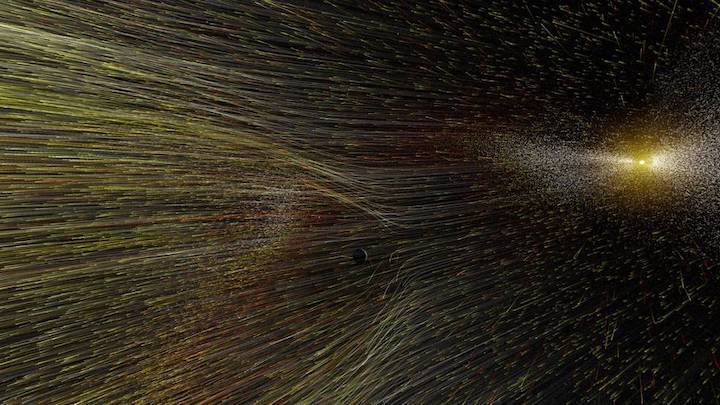4.12.2020

NASA has selected two SmallSat missions – a study of Earth’s outer most atmosphere and a solar sail spaceflight test mission – to share a ride to space in 2025 with the agency’s Interstellar Mapping and Acceleration Probe (IMAP).
The missions – the Global Lyman-alpha Imagers of the Dynamic Exosphere (GLIDE) and Solar Cruiser – were selected as Solar Terrestrial Probes (STP) Missions of Opportunity. GLIDE will help researchers understand the upper reaches of Earth’s atmosphere – the exosphere – where it touches space. Solar Cruiser demonstrate the use of solar photons for propulsion in space.
The launch of the IMAP mission in 2025 to the first Lagrangian equilibrium point (L1), about 1 million miles towards the Sun, will be a pathfinder for NASA’s new RideShare policy. With the policy, the agency’s Science Mission Directorate (SMD) will plan – from the inception of major missions – to take advantage of excess launch capacity and provide increased access to space for SmallSats. IMAP will help researchers better understand the interstellar boundary region, where the solar wind and the solar magnetic field it transfers to the edge of the solar system collide with galactic material and the galactic magnetic field.
Focusing on small satellites and tech demonstrations helps prove the capabilities of these smaller missions and pairing them with existing missions for launch provides more avenues for learning about the solar system and developing innovative technical capabilities.
“The study of the solar influence on interplanetary space and the area around our Earth has made great advances just in the past decade,” said Thomas Zurbuchen, associate administrator for science at NASA Headquarters in Washington. “I’m confident the next decade promises even more new discoveries and historic technology innovations.”
The science selection was made competitively from proposals to help better understand the fundamental nature of space and the interaction between space and Earth’s environment. As the selected science mission, GLIDE will study variability in Earth’s exosphere by tracking far ultraviolet light emitted from hydrogen. The exosphere is the outer region of Earth’s atmosphere that touches space – a region where atoms can escape Earth. Observing the global structure of the exosphere requires a telescope that is outside of the outer reaches of the atmosphere, which extend almost to the Moon. The IMAP launch trajectory to the inner Lagrangian point, the point of the Earth-Sun system that provides an uninterrupted view of the Sun, will provide just such a perspective for the GLIDE mission and is ideally suited for the first continuous observations of the exosphere and its variations in response to solar storm disruptions.
GLIDE will fill a measurement gap, as only a handful of comparable ultraviolet light images have previously been made from outside the exosphere. The mission will gather observations at a high rate, with a view of the entire exosphere, ensuring a global and comprehensive set of data. Understanding the ways in which Earth’s exosphere changes in response to influences of the Sun above or the atmosphere below, will provide us with better ways to forecast and, ultimately, mitigate the ways in which space weather can interfere with radio communications in space.
The principal investigator for GLIDE is Lara Waldrop at the University of Illinois at Urbana-Champaign. The GLIDE investigation is budgeted for $75 million.
Solar Cruiser was selected as the technology demonstration mission. Consisting of a nearly 18,000-square-foot (nearly 1,700-square-meter) solar sail, it will demonstrate the ability to use solar radiation as a propulsion system. Such a system could provide access to new orbits enabling high-value science, including SmallSat observations from deep space, out of the ecliptic plane, and in stationary orbits in the Earth’s geo-tail. Solar Cruiser will demonstrate one such orbit, where a spacecraft maintains position along the Earth-Sun line at a point closer to the Sun than L1. By positioning a monitoring spacecraft closer to the Sun, space weather scientists hope to obtain more advanced warnings of solar storms headed to Earth.
The principal investigator for Solar Cruiser is Les Johnson at NASA’s Marshall Space Flight Center in Huntsville, Alabama. The Solar Cruiser investigation is budgeted for $65 million.
A second STP science Mission of Opportunity, the Spatial/Spectral Imaging of Heliospheric Lyman Alpha (SIHLA), also was provided funding toward a final selection decision at a later date based on budget and RideShare opportunities. SIHLA would use an innovative technique to map the entire sky to determine the shape and underlying mechanisms of the boundary between the heliosphere, the area of our Sun’s magnetic influence, and the interstellar medium, a boundary known as the heliopause.
“Launching several missions together helps us maximize science while keeping costs down,” said Nicky Fox, Heliophysics Division director at NASA Headquarters in Washington. “We’re expanding the range and composition of a robust fleet of missions studying the Sun and space weather, and these two new selections will help advance into areas where we need to know more.”
From the start of IMAP mission formulation, SMD planned to include secondary spacecraft on the launch under the agency’s SMD Rideshare Initiative, which cuts costs by sending multiple missions on a single launch. This launch will also include the National Oceanic and Atmospheric Administration’s (NOAA) Space Weather Follow-On mission, which will expand that agency’s space weather forecasting.
“Expanding our capabilities and knowledge through experimental missions using SmallSats and tech demos enables us to do and try so many more things,” said Peg Luce, deputy director of the Heliophysics Division at NASA Headquarters in Washington. “Our Sun has thrown a lot of interesting questions at us lately, and we’re using every avenue to study space weather and its impact on our planet and our solar system.”
Funding for these missions comes from the Heliophysics Solar Terrestrial Probes program, which is managed by NASA's Goddard Space Flight Center in Greenbelt, Maryland.
Quelle: NASA
